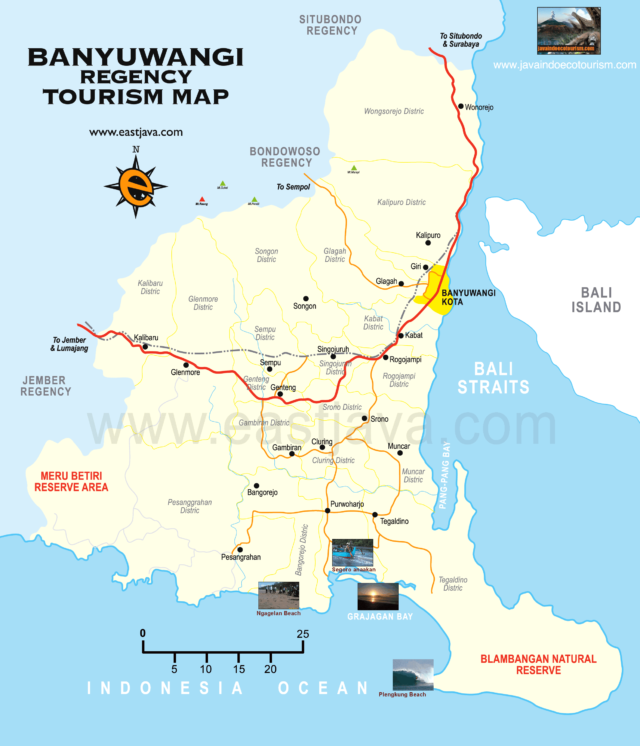<< Banyuwangi International Airport Open for Business >> news from Bali Discovery
爪哇最東邊的Banyuwangi國際機場開始營運,要去Bali北邊的Lovina及想去爬Ijen宜貞火山的旅客可從吉隆坡直飛,更方便了

Banyuwangi Airport Now Operating as an International Gateway to East Java and West Bali
On Wednesday, December 19, 2018, the Banyuwangi International Airport officialy earned its “international” status with the departure of the first international flight to Kuala Lumpur.
Departing on that flight at 8:20 am was Erna Samsul Hadi and two of her children as a special tribute to her late husband, Samsul Hadi, who is seen as championing the building of the airport during his reign as Regent of Banyuwangi 2000-2005.
The present day Regent of Banyuwangi, Abdullah Azwar Anas, told Kompas.com how he recalled Samsul lobbying Jakarta for support to build the airport on coast of East Java. “I remember that I was a member of the Indonesian House of Representatives (DPR-RI) at the time and how Regent Samsul came to Jakarta to ask support for a number of development projects in Banyuwangi, including the building of an airport in Banyuwangi”, said Anas.
Samsul Hadi had initially picked land in the sub-district of Glenmore for the construction of Banyuwangi’s Airport. Later in 2002, when it was determined that the land selected by Hadi was topographically unsuitable, the Central Government moved the location for the aerodrome to the Village of Blimbingsari. The airport project stalled for a number of years when Samul and Ratna, another Banyuwangi Regent were imprisoned for corruption in connection with the acquisition of the land for the Airport.
The gradual development of the Banyuwangi Airport continued, relying on funds from the National Budget. On December 29, 2010, the first commercial airline – Sky Aviation took off from the Airport. On that date a commemorative monument that officially opened the was signed by the then Deputy Minister of Transportation Bambang Susantoro, East Java Governor Soekarwo, and Banyuwangi Regent Abdullah Azwar Anas.
In October 2017, the Airport changed its name from Blimbingsari to Banyuwangi Airport and became a base of operation for the Bali International Flight Academy, Banyuwangi Flight Training Center and the Mandiri Utama Flight Economy (MUFA).
The terminal for the Banyuwangi Airport has a design-shape inspired by the “Udeng” – a traditional headdress worn by men of the local “Using Tribe”. The terminal has been designed based on green principles, able to remain cool and comfortable without resorting to the use of air-conditioning. Local architectural values are evident in the airport design, including the use of “Kling” – traditional windmills used by the Using People. To preserve its traditional roots, the Regency of Banyuwangi has forbidden zoning change that would eliminate the rice fields that surround the air gateway and impart a unique traditionally Indonesian atmosphere.
The first international flight departure from Banyuwangi by Citilink Airlines on Wednesday, December 19, 2018, coincided with the 247th anniversary of the Regency of Banyuwangi marked just one day before on December 28th.
The Banyuwangi Airport is operating as an international airport under a temporary 3-month permit issued by Jakarta on December 18, 2018 that is expected to be extended in 2019.
The Citilink Airline departure on December 18th was with an Airbus A-320 aircraft configured to carry 180 passengers. The flight will initially operate three times each week on Wednesdays, Fridays, and Sundays. The flight from Banyuwangi to Kuala Lumpur will take 2 hours 30 minutes departing at 8:20 am local time and landing in Malaysia at 12:10 pm. The return leg departs Kuala Lumpur at 1:20 pm landing in Banyuwangi at 3:10 pm.
The inaugural flight by Citilink carried 66 passengers.
Indonesian Tourism Minister Arief Yahya, who joined the inaugural flight to Kuala Lumpur, said his ministry is targeting 100,000 Malaysian will take advantage of the growing number of direct flight connections to Banyuwangi, boosted further by people-to-people promotion. The Minister is also optimistic that the potential for Indonesians living in East Java to fly to Malaysia is very strong.
Meanwhile, the Banyuwangi International Airport has seen passenger numbers increase dramatically from only 7,836 in 2010 to 140,683 in 2017. By October 2018, the number of passengers continues to grow significantly to 307,157.
Banyuwangi is destined to become a second air gateway for Bali, especially for traveler visiting Bali’s West and North.
